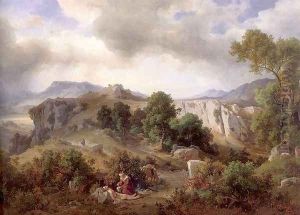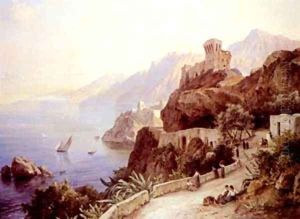Friedrich, the Elder Preller Paintings
Friedrich Preller the Elder was a German painter, born on April 25, 1804, in Eisenach, Thuringia. He is best known for his landscape paintings, which were highly influenced by the Romantic movement. Preller's work reflects a deep appreciation for nature, combined with a keen interest in classical themes and the desire to capture the sublime in the natural world.
Preller's early education in art began in Weimar, where he initially worked under the guidance of Johann Heinrich Meyer, a close associate of Johann Wolfgang von Goethe. Goethe himself took an interest in Preller's talent, encouraging his artistic development. Seeking to broaden his horizons, Preller traveled extensively throughout Europe, including Italy, where he was profoundly influenced by the work of the Old Masters and the picturesque landscapes. These experiences were pivotal in shaping his artistic style, which seamlessly blended classical ideals with romantic naturalism.
In 1831, Preller returned to Weimar, where he became a central figure in the city's artistic community. He was appointed as a professor at the Weimar Art School, influencing a generation of artists with his teachings. Preller's most ambitious project was the creation of a series of murals for the Ducal Museum in Weimar, illustrating scenes from Homer's Odyssey. This work, which occupied much of his career, is considered his masterpiece, showcasing his exceptional skill in composition and his ability to imbue classical subjects with a romantic sensibility.
Throughout his life, Preller continued to travel and paint, capturing landscapes across Germany and beyond. His artwork was characterized by meticulous attention to detail, vibrant coloration, and a profound sense of atmosphere, qualities that endeared him to both contemporaries and posterity. Friedrich Preller the Elder passed away on April 23, 1878, in Weimar, leaving behind a legacy that has cemented his place as one of the leading figures of 19th-century German romanticism in art. His works continue to be celebrated for their beauty, depth, and contribution to the landscape genre.

